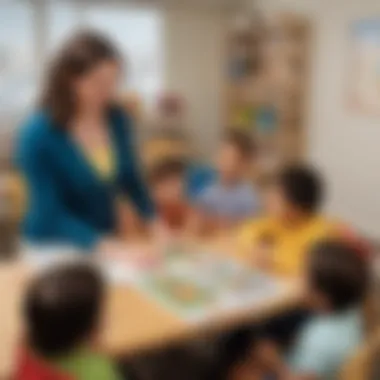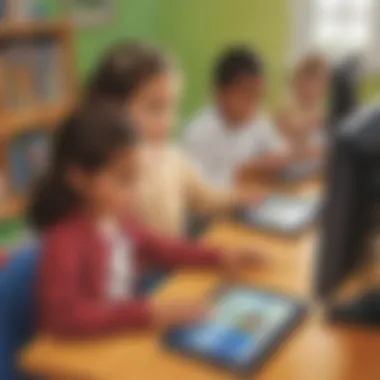Exploring the Essentials of Pre-K Literacy Curriculum


Intro
The foundation of literacy is crucial during the Pre-K years, as this stage forms a springboard for future learning. By engaging children with effective literacy curriculums, educators can foster essential skills. This article aims to dissect the elements that contribute to a successful Pre-K literacy curriculum. Understanding these components helps parents and educators facilitate early reading and writing habits among young learners. Each section will offer insights into curriculum elements, the role of interactive activities, and the integration of diverse resources, setting a context for enriched literacy experiences.
Interactive Learning Games
Popular Games
Incorporating educational games into the Pre-K literacy curriculum provides a practical approach to learning. Games that focus on phonemic awareness, vocabulary expansion, and comprehension are particularly beneficial. Examples of popular games include:
- ABC Mouse - A comprehensive program that adapts to different learning styles, providing children with interactive activities focused on literacy.
- Endless Alphabet - This game targets vocabulary development with colorful visuals and engaging animations.
Description of Top Educational Games
Educational games promote engagement among young learners. Starfall combines storytelling with practice in phonics and basic reading. The interactive nature of these games invites curiosity, supporting the child’s desire to learn through play. Storybird allows children to create their own stories with fixed vocabulary, blending creativity with literacy.
Benefits of Playing Educational Games for Kids' Cognitive Development
Educational games are vital for cognitive enhancement. They improve problem-solving skills and critical thinking. While children may be engrossed in fun, they gain necessary literacy skills in the process. Games also promote fine motor skills. When children interact with digital platforms, they learn to navigate technology, a crucial skill in today’s world. Moreover, such engagement fosters a positive attitude toward learning, setting a lifelong journey.
Game Reviews
In-Depth Reviews of Selected Educational Games
- ABC Mouse
This platform combines over 850 lessons across various subjects. Its comprehensive approach keeps children engaged and caters to varied learning benchmarks. - Endless Alphabet
Focused on vocabulary, this game presents delightful animations to reinforce meanings, ensuring that learning is memorable. - Starfall
Provides a robust phonics program. The engaging content helps young readers develop confidence in their skills.
Comparison of Gameplay and Learning Outcomes
Each game serves different needs. For example, Endless Alphabet shines in vocabulary building, while Starfall excels in phonics mastery. It is essential to evaluate how these games align with particular learning goals within the Pre-K literacy framework. Review the outcomes each game claims and match them against benchmarks to gauge effectiveness.
Educational Topics
Compilation of Articles Covering Various Subjects
Exploring a range of subjects in the curriculum enhances overall development. Subjects such as math, science, and languages should not be treated in isolation. Literacy crosses over into these areas, contributing to a more holistic approach. For instance, a simple science experiment can introduce new vocabulary while developing critical thinking.
Importance of Interdisciplinary Learning for Holistic Development
Educators recognize that interdisciplinary learning aids cognitive growth, as it fosters connections between varied subjects. This integration improves retention and application of knowledge by drawing connections among ideas, enriching the child’s learning experience.
Tips and Tricks
Practical Tips for Parents and Educators
Parents and educators can enhance the literacy journey with simple strategies:
- Read Aloud Daily - Reading together creates a shared experience.
- Utilize Technology - Select age-appropriate apps and games that facilitate learning.
Strategies for Making Learning Fun and Engaging
Incorporate everyday activities that involve literacy. Activities like grocery shopping can include word recognition on packaging. Likewise, singing songs with lyrics enhances vocabulary acquisition while being enjoyable. Engaging in storytelling, either through verbal accounts or puppetry, stimulates creativity.
Creative DIY Projects
Step-by-Step Guides
Engaging in creative DIY projects cultivates fine motor skills. Parents can create simple booklets with their children. Using paper and crayons, children can make their stories come to life. These activities promote creativity and encourage children to express their ideas and improve their writing.
Craft Ideas
Using household items inspires artistic expression. For example, using cardboard to create puppets allows children to enact stories, seamlessly integrating literacy with creative play. Crafting nurtures imagination and provides a physical format for stories they create, reinforcing language skills.
"Creativity is intelligence having fun." - Albert Einstein
Combining various elements within the Pre-K literacy curriculum ensures that young learners obtain fundamental skills necessary for their educational paths ahead.
Understanding Pre-K Literacy Curriculum
Understanding pre-K literacy curriculum is fundamental in setting a strong foundation for children's reading and writing skills. This education phase is crucial as it introduces young learners to the world of literacy, shaping their future academic experiences. A well-structured curriculum not only fosters foundational skills but also inspires curiosity and engagement in learning.
Definition and Importance


The pre-K literacy curriculum encompasses a range of activities and experiences designed to enhance children's literacy skills, focusing on aspects such as phonemic awareness, vocabulary development, and early comprehension abilities. These skills are critical because they form the basis for all future learning. Early exposure to literacy can influence a child's confidence and attitude towards reading. Nurturing this engagement helps in developing a lifelong love for learning.
"A solid literacy foundation in pre-K can significantly enhance a child's academic trajectory."
Theoretical Framework
To effectively implement a pre-K literacy curriculum, it is essential to understand the theoretical frameworks that guide literacy development. Various theories highlight the stages of learning that children undergo. Constructivist theories suggest that children learn best when they actively construct knowledge through play and exploration. This means integrating hands-on activities that allow them to experiment with sounds, words, and sentences. Theory and practice must go hand-in-hand; this emphasis on developmentally appropriate practices is critical.
Standards and Guidelines
Establishing standards and guidelines is key to maintaining consistency in the implementation of the pre-K literacy curriculum. Various educational organizations provide frameworks that educators can follow to ensure comprehensive literacy instruction. These guidelines should be flexible yet rigorous, accommodating diverse learning needs. Familiarity with the relevant standards helps teachers set clear objectives, design engaging lesson plans, and assess student progress effectively. Resources like the National Association for the Education of Young Children (NAEYC) offer crucial insights into best practices and pedagogical approaches.
By understanding these core aspects of the pre-K literacy curriculum, educators and parents can collaborate more effectively to prepare children for success in their educational journeys.
Key Components of a Literacy Curriculum
Understanding the essential elements of a literacy curriculum is crucial for fostering early literacy skills in children. Each component plays a unique role in developing a comprehensive approach to literacy education. By focusing on these key aspects, educators can establish a solid foundation that supports children’s growth in reading and writing. Integrating these elements effectively not only enhances educational outcomes but also instills a lasting love for literacy in young learners.
Phonemic Awareness
Phonemic awareness refers to the ability to recognize and manipulate the individual sounds in spoken words. This skill is fundamental for reading success. Children with strong phonemic awareness can break down words into their constituent sounds. This understanding aids them in developing decoding skills necessary for reading. Activities such as rhyming games or sound sorting can enhance phonemic awareness.
Educators should prioritize this skill since it directly impacts a child's ability to read. Research indicates that children who receive phonemic awareness training tend to perform better in later reading assessments. Thus, integrating phonemic awareness into the curriculum can yield long-term positive effects on literacy.
Vocabulary Development
Vocabulary development is another critical component of a pre-K literacy curriculum. A rich vocabulary contributes to better reading comprehension and communication skills. Children learn new words through exposure and practice in various contexts. Activities should include storytelling, word games, and discussions that introduce new vocabulary in meaningful ways.
Educators can foster vocabulary growth by exposing children to diverse literature. Reading a variety of genres and topics enables children to encounter words in different contexts. Encouraging children to express themselves using newly learned vocabulary encourages retention and understanding.
Reading Comprehension Strategies
Reading comprehension is the ability to understand and interpret the meaning of text. It goes beyond mere word recognition; it involves making connections, drawing inferences, and summarizing information. Strategies to support comprehension include asking questions, making predictions, and visualizing content.
Teachers can implement these strategies through guided reading sessions and interactive discussions. Modeling comprehension strategies allows children to see how skilled readers think. Additionally, integrating comprehension activities into read-aloud sessions can enhance engagement and understanding.
Writing Skills Preamble
Introducing writing skills during the pre-K years is essential for developing literacy. Children should engage in both oral and written expression early on. Activities can include drawing, labeling pictures, or simple sentence construction. The goal is to help children express their thoughts and creativity through writing.
As they progress, introducing basic grammar and sentence structure can further develop these skills. Offering various writing prompts and experiences encourages children to write regularly. Positive reinforcement during these activities can motivate children and foster a sense of achievement.
Integration with Other Subjects
Integrating literacy with other subjects enhances learning experiences for children. For example, using literacy skills in math or science through reading instructions or writing observations fosters a more comprehensive educational approach. This connection helps reinforce the relevance of reading and writing beyond the language arts.
Teachers should design lesson plans that combine literacy with different subject areas. This interdisciplinary approach not only keeps children engaged but also improves their overall understanding.
In summary, the key components of a literacy curriculum—phonemic awareness, vocabulary development, reading comprehension strategies, writing skills introduction, and integration with other subjects—are all critical for early literacy development. By focusing on these elements, educators can create a balanced and effective literacy curriculum that promotes a love for reading and writing in young learners.
The Role of Educators
Educators play a critical role in shaping the literacy experiences of pre-K children. Their influence stretches beyond mere teaching; it encompasses creating engaging learning environments, fostering a love for language, and bridging the gap between home and school literacy experiences. Understanding the role of educators is essential for optimizing the development of literacy skills among young learners. The effectiveness of a literacy curriculum heavily relies on how well educators are equipped with the right tools and strategies.
Teacher’s Qualifications
The qualifications of teachers in pre-K settings are paramount. Trained educators who understand child development and literacy strategies can create impactful learning experiences. They should possess a degree in early childhood education, supplemented with specialized training in literacy instruction. Familiarity with various instructional methods is also important. A qualified teacher combines knowledge of developmental milestones with practical skills in fostering a child’s engagement with reading and writing.
Well-prepared teachers are significant in guiding children through their initial literacy journey.
Ultimately, having teachers who are knowledgeable about phonics, vocabulary enhancement, and comprehension skills can lead to a more cohesive and effective curriculum delivery. Continuous professional development is necessary, ensuring that educators stay abreast of the latest research, pedagogical strategies, and educational technologies.
Effective Teaching Strategies
Effective teaching strategies are vital in enhancing literacy outcomes in pre-K classrooms. Educators should implement a variety of approaches that cater to different learning styles and needs. Strategies that promote active learning, such as guided reading sessions, collaborative storytelling, and phonics games, foster an engaging learning environment.
Using scaffolded instruction, teachers can build on children’s prior knowledge. By introducing concepts gradually and in a supportive manner, learners gain confidence and skills systematically. Another effective strategy is differentiated instruction, which allows teachers to tailor their approaches based on individual student needs. This method ensures that all children have access to the curriculum, regardless of their starting point.
Creating an Inclusive Learning Environment
An inclusive learning environment is critical in pre-K literacy education. It brings together children from diverse backgrounds, including varying abilities and language proficiencies. Educators must strive to create a setting where every child feels valued and respected. When children see themselves reflected in the curriculum, their motivation for learning increases.


Key aspects include:
- Using diverse literature that represents multiple cultures and experiences.
- Implementing activities that promote collaboration and social interaction.
- Being responsive to individual children's needs, ensuring that everyone has equal access to learning opportunities.
Through inclusive practices, educators help children develop social and emotional skills alongside literacy. Ultimately, nurturing an inclusive environment not only supports literacy growth but also cultivates a sense of community and belonging in the classroom.
Learning Activities and Approaches
Engaging children through thoughtfully designed learning activities and approaches is essential for successful pre-K literacy instruction. These activities stimulate curiosity and creativity and are also pivotal in reinforcing foundational literacy skills. By using varied methods, educators can cater to different learning styles and needs, ensuring that all children benefit from the curriculum. This section will delve into specific approaches, highlighting their significance and positive impact on literacy development.
Interactive Storytelling
Interactive storytelling goes beyond reading a text. It involves the active participation of children in the storytelling process. This method encourages children to engage with the story by asking questions, predicting outcomes, and expressing their thoughts. It fosters a deep connection to the narrative, significantly enhancing comprehension and retention.
The benefits of interactive storytelling include:
- Enhanced Listening Skills: Children learn to focus on the narrative, improving their ability to comprehend and retain information.
- Vocabulary Expansion: As they hear rich language and are encouraged to respond, children naturally absorb new words.
- Critical Thinking: Asking questions and predicting outcomes hones analytical skills, crucial for future learning.
Additionally, teachers can incorporate props or digital tools to make stories more immersive. The key is to create an environment where children feel comfortable expressing their ideas and emotions related to the story.
Literacy Games and Centers
Literacy games serve as dynamic tools in the pre-K classroom, marrying fun with educational outcomes. These games can take place in dedicated literacy centers, designed to encourage exploration and creative problem-solving.
Some common components of literacy games include:
- Word Puzzles: Activities that challenge children to identify and form words stimulate phonemic awareness and spelling skills.
- Role-Playing: Creating scenarios that allow children to act out stories or roles from their favorite books enhances engagement and understanding.
- Comparative Activities: Games that ask children to match words or images help build vocabulary and comprehension.
Setting up literacy centers provides children with a space dedicated to learning through play. Stations can include different activities like letter recognition games, reading corners, or writing stations where they can experiment with letters and words.
Use of Technology in Literacy Instruction
The integration of technology in literacy instruction offers exciting opportunities for young learners. Tools such as tablets, interactive whiteboards, and educational apps can enhance the learning experience, making it more engaging and effective.
Technology in literacy can:
- Provide Access to Diverse Materials: Children can explore a wide range of texts and topics, allowing for personalized learning paths.
- Encourage Interactive Learning: Many applications include interactive elements that respond to children’s input, promoting active participation.
- Facilitate Skill Building: Digital games and activities can address specific literacy skills, from phonics to comprehension, in a playful manner.
However, it is crucial to ensure that technology complements rather than replaces traditional learning methods. Balancing screen time with hands-on activities is vital to maximize benefits.
Incorporating varied activities not only stimulates children’s interest but also ensures comprehensive literacy skill development, setting a strong foundation for future learning.
Assessment in Literacy Development
Assessment plays a crucial role in the literacy development of young learners in pre-K settings. It serves as a systematic method to evaluate the skills and abilities of children, aiding educators in tailoring instruction to meet diverse needs. Proper assessment not only identifies strengths and weaknesses in literacy skills but also informs teaching practices to ensure that all children progress effectively. Moreover, effective use of assessments can bridge communication between educators and families, fostering a collaborative effort in supporting children's literacy growth.
Formative Assessments
Formative assessments are ongoing assessments that take place during the learning process. These assessments provide immediate feedback to both students and teachers. They help in identifying how well children are grasping the concepts being taught. For instance, teachers might use observations, quizzes, or group discussions to gauge student understanding. This type of assessment is essential because it allows educators to make timely adjustments to their teaching strategies.
- Benefits of Formative Assessments
- Encourages active learning
- Supports individualized instruction
- Makes learning goals transparent for students
Using formative assessments effectively creates a more responsive teaching environment. They enable educators to foster a love for learning, as children can see their progress.
Summative Assessments
Summative assessments, on the other hand, are conducted at the end of an instructional period. They measure the cumulative knowledge and skills that students have acquired throughout the course. These assessments can take various forms such as standardized tests, projects, or final presentations.
Summative assessments are important for several reasons:
- Provide an overview of student learning outcomes
- Help to evaluate the effectiveness of the literacy curriculum
- Inform future instructional practices based on overall performance
While summative assessments can have a pivotal role, they also come with challenges. The emphasis on high-stakes testing can create stress for young learners. Therefore, it is key to balance these evaluations with more supportive forms of assessment.
Using Assessment Results to Inform Instruction
Once assessments are performed, analyzing the results is vital for guiding future teaching. This process involves reflecting on areas where students excelled and aspects needing further development. By interpreting this data, educators can modify their lessons to better address students' needs.
Incorporating assessment results can lead to improved instructional strategies such as:


- Differentiating tasks for various skill levels
- Identifying resources that can support struggling students
- Engaging families with insights into their child’s learning
"Assessment is not just a tool for measuring learning, but a pathway to cultivate it.”
Engaging Families in Literacy Education
Engaging families in literacy education is essential for developing strong literacy skills in pre-K children. This involvement fosters a positive association with reading, enhances vocabulary, and supports comprehension in young learners. When families actively participate in literacy activities, children tend to perform better academically and exhibit a greater enthusiasm for learning.
By involving families, educators create a supportive environment that acknowledges diverse backgrounds and languages. This awareness can help tailor literacy approaches that resonate with different family circumstances, thereby enriching the learning experience. Parental involvement also emphasizes the importance of literacy outside the classroom, reinforcing that reading is a daily habit.
Strategies for Parental Involvement
Parents play a critical role in their child's literacy development. To foster this involvement, schools and educators can implement various strategies:
- Workshop Sessions: Organizing workshops provides parents with tools and techniques to support their children’s reading at home. Topics can include phonemic awareness, shared reading practices, and engaging activities that promote literacy.
- Reading Programs: Implementing family reading nights encourages parents to participate alongside their children. This also builds community, as families can share experiences and insights regarding literacy.
- Communication Channels: Regularly updating parents through newsletters or social media helps maintain an open line of communication. Information about classroom activities, recommended books, and learning tips can aid parents in reinforcing literacy skills at home.
- Goal-Setting: Helping families set literacy goals can motivate both parents and children. For example, they could aim to read a certain number of books each month or engage in daily storytelling sessions.
Resources for Parents
To further support parental involvement, it’s important to provide valuable resources. Here are some useful tools:
- Books and Literature: Sharing age-appropriate and diverse literature can inspire parents to read aloud with their children. Websites like Wikipedia provide lists of recommended children’s books.
- Online Resources: Websites like Britannica offer articles and tips on effective reading practices for families.
- Community Libraries: Encourage families to explore their local library. Many libraries offer storytime events and literacy programs specifically designed for young children and their parents.
Engaging families in literacy education not only strengthens a child’s reading skills, but it also builds a lifelong love for literature and learning.
Challenges in implementing Pre-K Literacy Curriculum
Implementing an effective pre-K literacy curriculum entails various challenges that can affect the overall success of young learners. Understanding these challenges is crucial, as it enables educators and families to navigate potential obstacles and develop strategies to address them effectively. By acknowledging these hurdles, stakeholders can foster environments that promote literacy skills in children.
Limited Resources
One of the most significant challenges in pre-K literacy curriculum implementation is limited resources. Many early childhood programs operate under tight budgets, leading to inadequacies in materials and staffing. For instance, a lack of access to high-quality books or technology can hinder the development of literacy in young children. It is also vital for educators to have training and professional development opportunities that support their teaching practices.
To overcome these limitations, organizations can prioritize grant applications and funding proposals to access additional resources. Collaboration with local libraries can also provide opportunities for children to engage with diverse reading materials.
"Access to quality resources is essential for fostering literacy skills among pre-K students."
Diverse Learning Needs
The diversity in learning needs among students presents another challenge for implementing literacy curriculums. Children come to the classroom with varying backgrounds, abilities, and learning styles. Some may be multilingual, while others might have special educational needs that require tailored instruction. A one-size-fits-all approach is unsuitable in these scenarios, as it can leave some children behind.
To address diverse learning needs, educators can adopt differentiated instruction strategies. For example, implementing tactile learning experiences, visual aids, and auditory tools can cater to various learners. Building a responsive curriculum that acknowledges each child's unique strengths is key to effective literacy development.
Balancing Curriculum Rigor with Play
Lastly, finding a balance between structured literacy instruction and play-based learning poses ongoing challenges. Play is an essential component of early childhood education, as it encourages creativity and social skills. However, curriculum expectations can often lean heavily towards assessment-driven approaches, which may conflict with the natural inclination for play in young children.
Educators must strive to create a harmonious blend of instruction and play. They can achieve this by integrating literacy activities into play-based contexts, fostering meaningful engagement with literacy concepts while still allowing children freedom to explore their interests. Tailoring curriculum elements so that they include playful learning opportunities allows children to develop literacy skills in a manner that feels organic.
Recognizing and addressing these challenges in implementing a pre-K literacy curriculum is essential. Schools, families, and communities must work together to ensure that children receive the rich educational experiences they need to thrive as learners.
Future Directions in Pre-K Literacy Instruction
The landscape of early childhood education continues to evolve. Future directions in pre-K literacy instruction are crucial as they align with the needs of modern learners. Emphasizing adaptability and integration of various pedagogical approaches enhances children's literacy skills. Furthermore, it prepares them for an increasingly digital world. The focus on updating curricula not only enriches literacy practices but also fosters the development of essential skills for lifelong learning.
Emphasis on Digital Literacy
In today’s connected world, digital literacy plays a significant role in education. Pre-K literacy must now include activities to engage children with technology. This integration helps young learners to navigate digital environments than can also provide access to a wealth of resources. Parents and educators must select age-appropriate tools, such as educational apps and online stories, that support literacy development without overwhelming children.
Digital literacy is not simply about using devices; it's about developing critical thinking skills essential for the future.
Children who engage with interactive e-books or online literacy games develop skills that traditional books cannot offer. They learn to identify and interact with information actively. Thus, educators should consider how digital elements can be incorporated alongside traditional methods to form a balanced approach.
Embedding Social Emotional Learning
Integrating social emotional learning (SEL) into literacy instruction greatly benefits young children. SEL focuses on skills like self-awareness, empathy, and emotional regulation. When children can express themselves and understand their feelings, they become more engaged in learning. This connection helps them relate to stories on a personal level, thus enhancing comprehension.
Activities that promote SEL can include group storytelling or discussing characters' emotions in a story. Encouraging discussions on moral dilemmas or character decisions fosters critical thinking and emotional insight. Similarly, ensuring that literacy materials represent diverse experiences cultivates an understanding of empathy and inclusivity.
Research-Based Practices in Literacy Instruction
Research-based practices form the backbone of effective literacy instruction. As education evolves, it is vital to rely on studies and findings to inform teaching methodologies. For instance, phonics instruction, supported by numerous studies, enhances children's decoding skills.
Using evidence-based strategies allows educators to select techniques that are most effective for varied learning styles. These methods can include:
- Differentiated Instruction: Tailoring lessons to meet individual needs.
- Balanced Literacy: Combining phonics with whole language approaches.
- Reading Aloud: Enhancing comprehension and vocabulary through shared reading experiences.
Consistent evaluation of literacy results is necessary to adapt instruction and interventions. This ensures that teachers are prepared to meet diverse classroom needs. An informed approach guarantees that pre-K educators remain effective leaders in literacy development.













